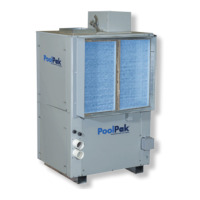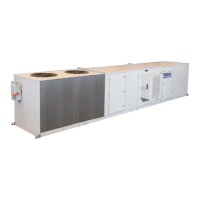Do you have a question about the PoolPak AW 1400 and is the answer not in the manual?
Covers essential concepts like environmental control, cost, moisture, and air quality in indoor pool design.
Details factors affecting occupant comfort and the critical role of proper pool water chemistry.
Overview of equipment choices: ventilation, mechanical dehumidification, hybrids, and other technologies.
Covers airside design principles including supply air, return air, ductwork, and air distribution methods.
Discusses auxiliary heating, negative pressure, duct materials, vapor barriers, and window/door insulation.
Explains the core function of dehumidifying pool enclosure air using vapor compression and heat recycling.
Utilizes dew point control for accurate moisture level management, preventing building damage.
Describes how the PoolComPak system draws in moist air, condenses moisture, and reheats the air.
Overview of the ECC-PCP control system for managing pool environment and its features.
Details networking, optional cooling/heating, and available features and options for PoolComPak systems.
Describes the self-contained, all-in-one dehumidification system for rooftop installations.
Covers system selection, available configurations, and typical applications for PoolComPak units.
Provides key performance and dimensional data for RoofPak units, including capacities and dimensions.
Presents overall unit dimensions for PCP RoofPak models in graphic and tabular formats.
Lists the weights of RoofPak models based on their configuration.
Detailed performance summaries for PoolComPak AW and HCD series units at specific operating conditions.
Provides overall unit dimensions for PoolComPak Horizontal AW/HCD models, including various configurations.
Details hot water coil capacities for vertical and horizontal PoolComPak models.
Specifies the size of the outside air damper for various PoolComPak models and configurations.
Provides factory refrigerant R410A charge information for Air Cooled and Water Cooled condensers.
Presents performance data for remote air-cooled condensers, including dimensions, motor specs, and ampacity.
Details general information, specifications, and sizing for electric duct heaters used in the system.
Overview of the installation process for PoolComPak units, including placement and connections.
Illustrates the typical system layout and connections for PoolComPak units to the natatorium and piping.
Covers unit handling, clearance requirements, mounting procedures, and inspection upon receipt.
Details electrical power, control wiring, and condensate piping connections according to codes.
Details the installation procedure for mounting units on a specially designed roof curb.
Details field wiring requirements for the ECC-PCP system, including sensor and panel connections.
Guides installation of temperature sensors and optional systems like economizers for proper operation.
Covers installation of air and water-cooled condensers, including location requirements and pool water piping.
Details connections for auxiliary heating, alarm systems, fire control, and various input sensors.
Provides guidelines for field installation of piping, including materials, sizing, and refrigerant/oil charging procedures.
Details the functionality and navigation of the Remote Interface Unit (RIU) for system control.
Explains how to view system status screens, including temperature, humidity, and operational modes.
Guides users on how to adjust set points for air temperature, humidity, and pool water temperature.
Explains purge mode operation and how to access detailed system status information.
Describes the master/slave network operation for multiple PoolComPak units, ensuring coordinated control.
Covers changing set points across networks and accessing the ECC-PCP service menu.
Details system history, manual operation modes, and utility settings for configuration and access.
Periodic maintenance promotes extended equipment life; simple checks can identify potential problems early.
Focuses on daily logging of pool water chemistry, following National Spa and Pool Institute standards.
Includes inspecting/cleaning air filters, checking condensate drains, and verifying blower motor operation.
Covers inspecting circuits for leaks/corrosion, checking electrical connections, and cleaning coils.
Diagram showing how to connect auxiliary heaters to multiple PoolComPak units in a networked system.
Illustrates connections for auxiliary heaters for two pools, showing separate or single heater configurations.
Comprehensive diagram showing all field wiring connections for sensors, controls, and power to the PoolComPak unit.
Diagram illustrating how to connect the PoolComPak system to a building's fire control system.
| Brand | PoolPak |
|---|---|
| Model | AW 1400 |
| Category | Dehumidifier |
| Language | English |


